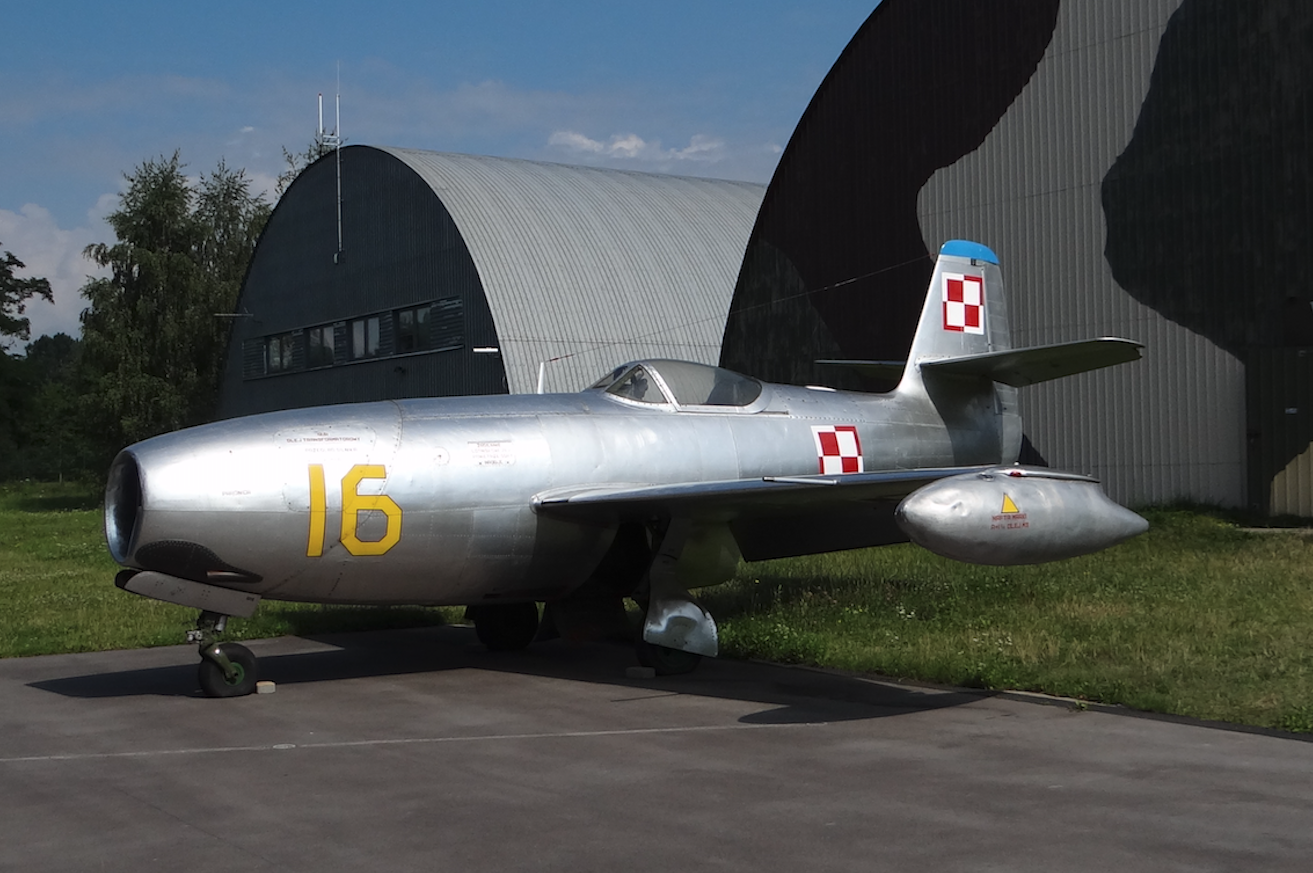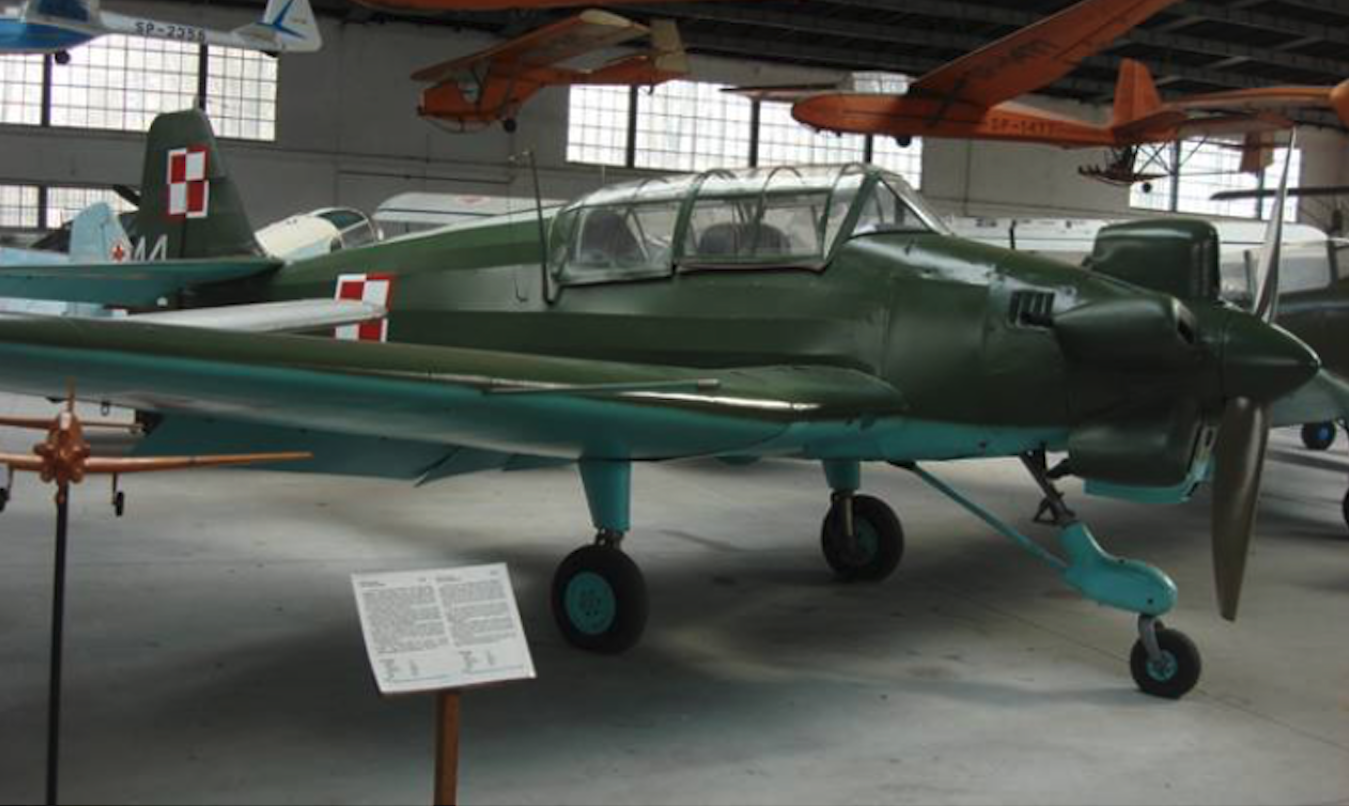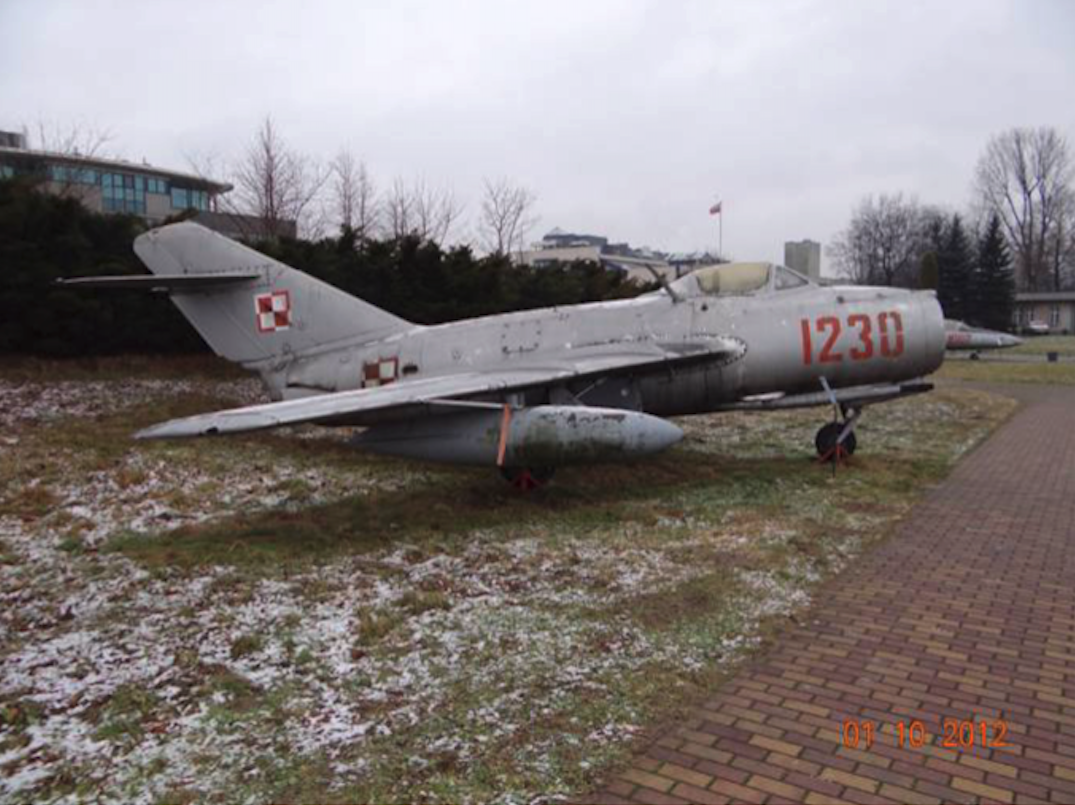Kraków 2012-03-20
Państwowe Zakłady Lotnicze – Wytwórnia Sprzętu Komunikacyjnego – Mielec.
1950r.-1956r. Część 2.
Jakowlew Jak-17. 1949 rok.
W 1948 roku, w Polsce opracowano siedmioletni plan rozwoju lotnictwa wojskowego na okres 1949 – 1955. W planach tych była mowa o pozyskaniu nowych samolotów myśliwskich poruszanych przyszłościowym napędem w postaci silników turboodrzutowych. Ponieważ Polska nieubłaganie wpadała w strefę wpływów nowego okupanta, jedynym dostawcą nowego sprzętu mógł być tylko Związek Sowiecki. Rozważano możliwość zakupu samolotów typu Jak-15, ale CCCP nie odważył się na sprzedaż tych maszyny, nawet krajom zależnym od siebie. Samolot Jak-15 był wyjątkowo awaryjny, a czas lotu nie przekraczał 15 minut. Realny okazał się zakup samolotów typu Jak-17 i Jak-17 W, będący wersją szkolno-treningową. Z początkiem 1950 roku, Polska dokonała zakupu pierwszej partii myśliwców Jak-17, złożonej z trzech maszyn. Samoloty były fabrycznie nowe. Maszyny te dostarczono jednym transportem kolejowym do Radomia. Pierwszy Polski samolot Jak-17 został złożony w lipcu 1950 roku.
Na przełomie 1949/1950 roku, rozpatrywano w Polsce możliwość uruchomienie produkcji licencyjnej samolotów Jak-17, przez krajowy przemysł lotniczy. W połowie 1950 roku, rozpoczęto przygotowania do tej produkcji, mając do dyspozycji trzeci zakupiony egzemplarz jednomiejscowego Jak-17. Samolot miał otrzymać oznaczenie PZL Mielec G-1. Oznaczenie PZL-Mielec G-1 U miała otrzymać wersja dwumiejscowa, czyli Jak-17 W Agata. Pracami kierował główny konstruktor mieleckiej wytwórni inż. Zygmunt Szczeciński. Zorganizował on zespół kierowany przez inżyniera Stanisława Lipińskiego. Zespół opracował dokumentację konstrukcyjno-technologiczną i przystąpiono do montażu pięciu pierwszych prototypów. Montażu nie ukończono, gdyż przystąpiono do prac nad samolotem Jak-23.
Równolegle w rzeszowskiej WSK poczyniono przygotowania do podjęcia produkcji licencyjnej silników RD-10 A pod nazwą G-2. Plany te także zarzucono. Wykonano tylko 30 egzemplarzy, które wykorzystano do napędu eksploatowanych samolotów Jak-17 W.
Jakowlew Jak-23. 1951 rok.
Z początkiem 1951 roku, gotowe były już plany Polskiego Rządu, o rozwoju Polskiego Lotnictwa Wojskowego i o zakupie licencji na produkcję Jak-23. W lutym 1951 roku, zapadła decyzja o wstrzymani pracy nad uruchomieniem produkcji samolotu myśliwskiego G-1 (Jak-17), a rozpoczęcie prac nad przygotowaniem do produkcji licencyjnej samolotu G-3 (Jak-23).
W tym czasie rozwój obronności był jeszcze ściśle związany z rozwojem gospodarczym zniszczonego po wojnie kraju. Zakup ten był logiczny. W związku z tym do Mielca przesłano z CCCP jeden kompletny samolot, który miał posłużyć, jako wzorzec. Samolot ten był silnie strzeżony. Przed uruchomieniem produkcji seryjnej nieliczne osoby miały dostęp do samolotu. Planowano produkcję w Mielcu skrzydeł i tylnej części kadłuba, w Świdniku – przedniej części. Silniki miano dostarczać bezpośrednio z CCCP.
Produkcji nie podjęto, gdyż uległy po raz kolejny zmianie plany i wprowadzono samoloty MiG-15. O zaawansowaniu prac do podjęcia produkcji niech świadczy fakt, że na złom przekazano około 25 ton blach, nie licząc tych blach, które ponownie wykorzystano.
LWD CSS Junak-2.
Zespół konstruktorów z LWD opracował udany szkolno-treningowy samolot Junak. Po próbach, w 1949 roku, opracowano i oblatano ulepszony wariant Junak 2, o lepszym wyposażeniu dla potrzeb wojska i dobrych własnościach pilotażowych, który następnie skierowano do produkcji w 1951 roku. Jego produkcję umieszczono w PZL-Mielec. Jednak w Mielcu zbudowano zaledwie 3 egzemplarze, bo całą produkcję przeniesiono do Warszawy, gdzie zbudowano 105 samolotów Junak 2. Powodem było umieszczenie produkcji wojskowych samolotów myśliwskich w Mielcu. W międzyczasie, zespół LWD został rozwiązany w 1949 roku i dopracowanie samolotu Junaka 2 zostało przejęte przez warsztaty Centralnego Studium Samolotów (CSS) w Warszawie. Wkrótce powstał Junak-3.
Lim-1. Licencyjny MiG-15. 1952 rok.
W związku z wojną w Korei, rosjanie postanowili dozbroić „sojusznicze” armie. Ich przemysł nie był jednak w stanie w odpowiednio krótkim czasie zbudować odpowiednio dużej liczby myśliwców. Musieli podjąć ryzyko i przekazać licencje najnowszych i najlepszych swoich myśliwców. W Polsce wstrzymano w tym czasie przygotowania do budowy myśliwców; Jak-17 (G-1), Jak-23 (G-3), silników RD-10 (G-2). Na podstawie uchwały Rządu Polskiego z dnia 19 czerwca 1951 roku, nr 12, postanowiono zrealizować plan zakupu licencji na produkcję myśliwców MiG-15. Na miejsce produkcji wytypowano międzywojenny COP (Centralny Okręg Przemysłowy), a w nim Mielec, Świdnik i Rzeszów. Rozbudowano także zakład na Okęciu oraz kilka mniejszych zakładów produkcji pomocniczej.
Polski samolot oznaczono, jako Lim-1, od skrótu Licencyjny Myśliwiec konstrukcja nr 1. Na czele programu stanął inżynier Zygmunt Szczeciński. Założenia były następujące; Podstawową fabryką miał być nowo budowany zakład WSK Świdnik. Budowę zakładu rozpoczęto w 1949 roku. Część produkcji płatowca miano ulokować w Mielcu. Silniki miał produkować zakład WSK Rzeszów. Montażem końcowym miał się zająć WSK Świdnik.
Tu parę słów wyjaśnienia odnośnie skrótu WSK. Skrót ten oznacza Wytwórnię Sprzętu Komunikacyjnego. Nazwa ta była zakamuflowaniem wojskowego charakteru produkcji. Nazwa Państwowe Zakłady Lotnicze łatwo się kojarzy z samolotami, a więc ewentualną produkcją samolotów bojowych. Mimo to nazwa PZL Mielec funkcjonowała w potocznych rozmowach niezmiennie.
Budowa zakładów w Świdniku.
W dniu 1 stycznia 1951 roku, Centralny Zarząd Przemysłu Sprzętu Komunikacyjnego w Warszawie, w oparciu o Uchwałę Rady Ministrów, Zarządzenie Ministra Przemysłu Ciężkiego z dnia 14 grudnia 1950 roku, powołał do istnienia Zakład WSK Nr 5 w Świdniku. Największe nasilenie prac budowlanych miało miejsce w okresie 1950-1953. Pierwsze hale zbudowano w okresie 1950-1952, z konstrukcji przeniesionych z Krzesin koło Poznania, zaś od 1953 roku, oddano do użytku podstawowe obiekty produkcyjne, pomocnicze i usługowe.
Proces budowy fabryki w Świdniku z natury rzeczy musiał trwać kilka lat, a samoloty potrzebne były jak najszybciej. Dlatego naczelne władze Polski zdecydowały o uruchomieniu głównej produkcji Lim-1 w Mielcu.
Zakłady w Mielcu.
W 1951 roku, do Mielca dostarczono nowy samolot MiG-15 nr 113-074, zbudowany przez zakłady w Kujbyszewie w CCCP. Był to wzorcowy egzemplarz dla uruchomienia produkcji seryjnej w Mielcu.
Pierwszy samolot Lim-1 nr 1A 01-001 został zbudowany pośpiesznie w lipcu 1952 roku, aby zdążyć z zaprezentowaniem go podczas komunistycznego święta 22-Lipca. Samolot został oblatany w dniu 17 lipca 1952 roku, przez majora pilota Eugeniusza Pniewskiego. W dniu 27 września 1952 roku, samolot ten został dostarczony do 13. PLM, stacjonującego w tym czasie na Lotnisku Bemowo. Samolot ten należał do pierwszej serii produkcyjnej, złożonej z 6 maszyn dostarczonych w podzespołach z CCCP. Pozostałe 5 egzemplarzy ukończono z początkiem września 1952 roku.
Tak rozpoczęła się w Mielcu produkcja myśliwców Lim-1. Trwała ona do dnia 31 sierpnia 1954 roku, czyli przez dwa lata. W tym czasie zbudowano w Mielcu 237 egzemplarzy samolotów Lim-1, w 12 seriach produkcyjnych.
Lim-2. 1954 rok.
Biuro OKB Mikojana i Guriewicza nie ustawało w doskonaleniu samolotu MiG-15. Tak narodził się MiG-15 bis, który otrzymał mocniejszy silniki i lepsze wyposażenie awioniczne. Już w styczniu 1953 roku, Polska odebrała 20 nowych maszyn MiG-15 bis. Naturalnym było, więc uruchomienie produkcji w Mielcu, zastępując Lim-1 samolotem Lim-2. Na przełomie 1953/1954 roku, do Mielca dostarczono samolot MiG-15 bis nr 1350086, który stał się wzorcem do produkcji samolotów oznaczonych Lim-2. Egzemplarz ten w 1957 roku, został przekazany do Instytutu Lotnictwa, gdzie otrzymał rejestrację SP-GLZ i służył do prac badawczych. W dniu 4 listopada 1972 roku, został przekazany do Muzeum w Krakowie.
W dniu 17 września 1954 roku, został w Mielcu zbudowany pierwszy myśliwiec Lim-2 nr 1B 01-01. Należał on do pierwszej serii produkcyjnej złożonej z 21 maszyn. W dniu 23 listopada 1956 roku, zakończono produkcję samolotów Lim-2, których zbudowano 510 sztuk, w 20 seriach.
Lim-5. 1956 rok.
Już w 1955 roku, zapadła decyzja o podjęciu produkcji seryjnej myśliwców MiG-17. Sowieci początkowo wyrazili zgodę na produkcję wersji MiG-17 F, czyli bez celownika radiolokacyjnego. Na wersję z celownikiem radiolokacyjnym przyszedł czas później. Z początkiem 1956 roku, w WSK Mielec rozpoczęto przygotowania do produkcji samolotu MiG-17 F pod oznaczeniem Lim-5.
Pierwszy egzemplarz Lim-5 z numerem fabrycznym 1C 00-01 opuścił halę fabryczną w Mielcu w dniu 25 maja 1956 roku, czyli w czasie, kiedy trwała jeszcze produkcja zamówionych Lim-2. Samolot należał do partii próbnej złożonej z trzech maszyn o numerach od 1C 00-01 do 1C 00-03. Maszyn zostały poddane próbom zakładowym i wojskowym. W dniu 28 listopada 1956 roku, maszyny te przekazano wojsku i przebazowano na lotnisko w Bemowie. Było to w pięć dni po dostarczeniu wojsku ostatniego egzemplarza myśliwca Lim-2. Pierwszy egzemplarz samolotu Lim-5 o numerach 1C 00-01 stał się samolotem dowódcy wojsk lotniczych. Po latach trafił do Dęblina, jako pomoc naukowa.
Od 8 lutego 1957 roku do 19 kwietnia 1957 roku, próby przechodził pierwszy egzemplarz drugiej serii produkcyjnej 1C 02-01. Próby przeprowadzali piloci Z. Stręk, Z. Korab i M. Skowroński. Egzemplarz ten nie miał jeszcze radio-dalmierza SRD-1 M, z powodu opóźnień dostaw z CCCP. Był także cięższy od wzorca sowieckiego o 130 kg, przypuszczalnie dlatego, że w Polskim samolocie uwzględniono już zmiany, których wzorzec sowiecki nie posiadał. Maszyna ta nie została przekazana wojsku, tylko posłużyła, jako wzorzec dla produkcji seryjnej.
Wiosną 1957 roku, produkcja Lim-5 szła już pełną parą. Do końca 1957 roku, z taśmy montażowej w Mielcu zjechało 222 płatowców. Produkcję Lim-5 zakończono 30 czerwca 1960 roku, po zbudowaniu 477 sztuk, z czego 120 myśliwców z 6, 7, 8 i 9 serii dostarczono do NRD. Łącznie serii produkcyjnych było 19. Ostatni wyprodukowany w dniu 30 czerwca 1960 roku, Lim-5 nosi oznaczenie 1C 19-14. Zasadnicza produkcja trwała 44 miesiące, a średnie tempo produkcji wyniosło 11 maszyn na miesiąc. Należy podkreślić dobre opanowanie produkcji samolotu przez fabrykę i dobry poziom wykonania wszystkich egzemplarzy.
Opracował Karol Placha Hetman






